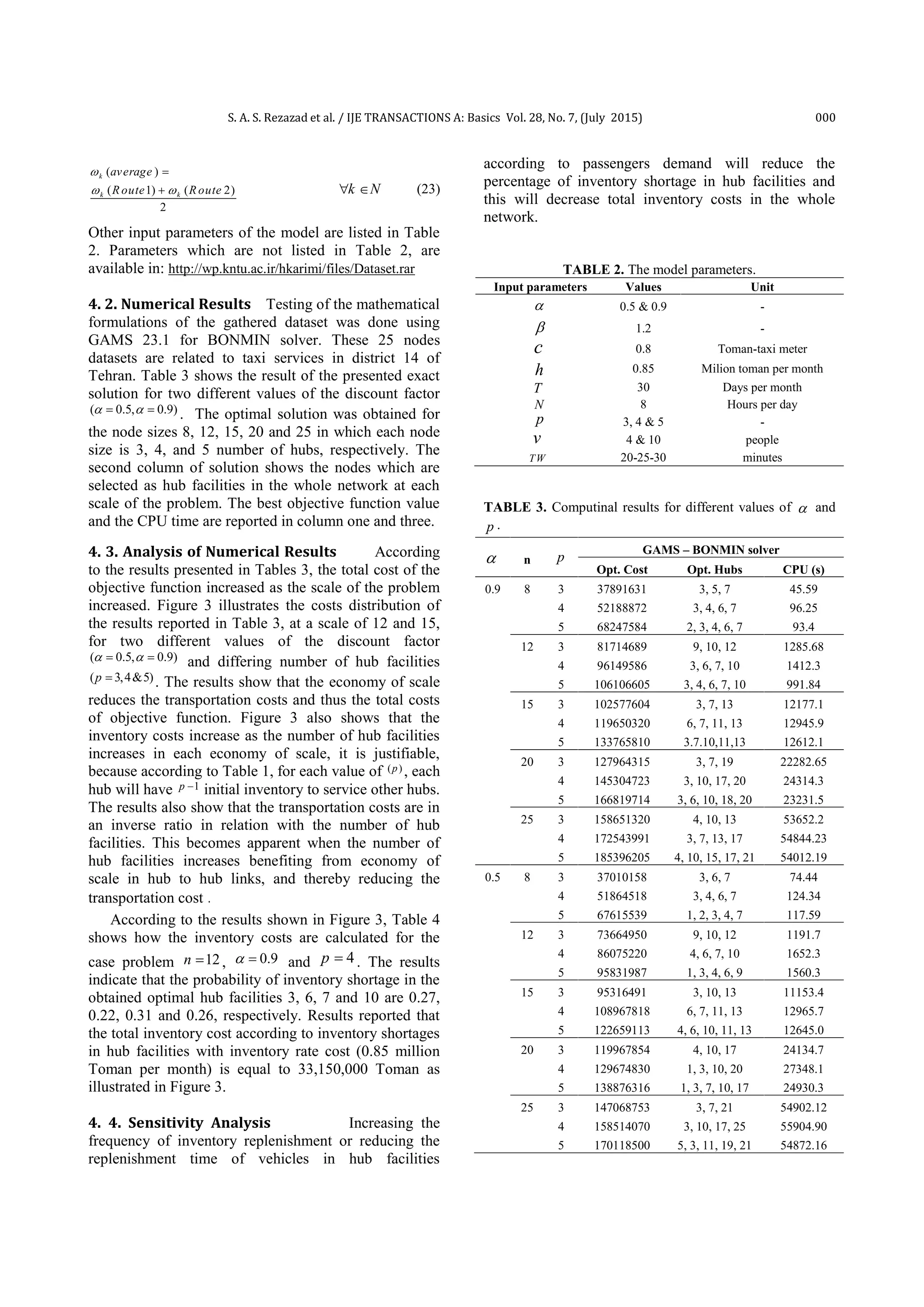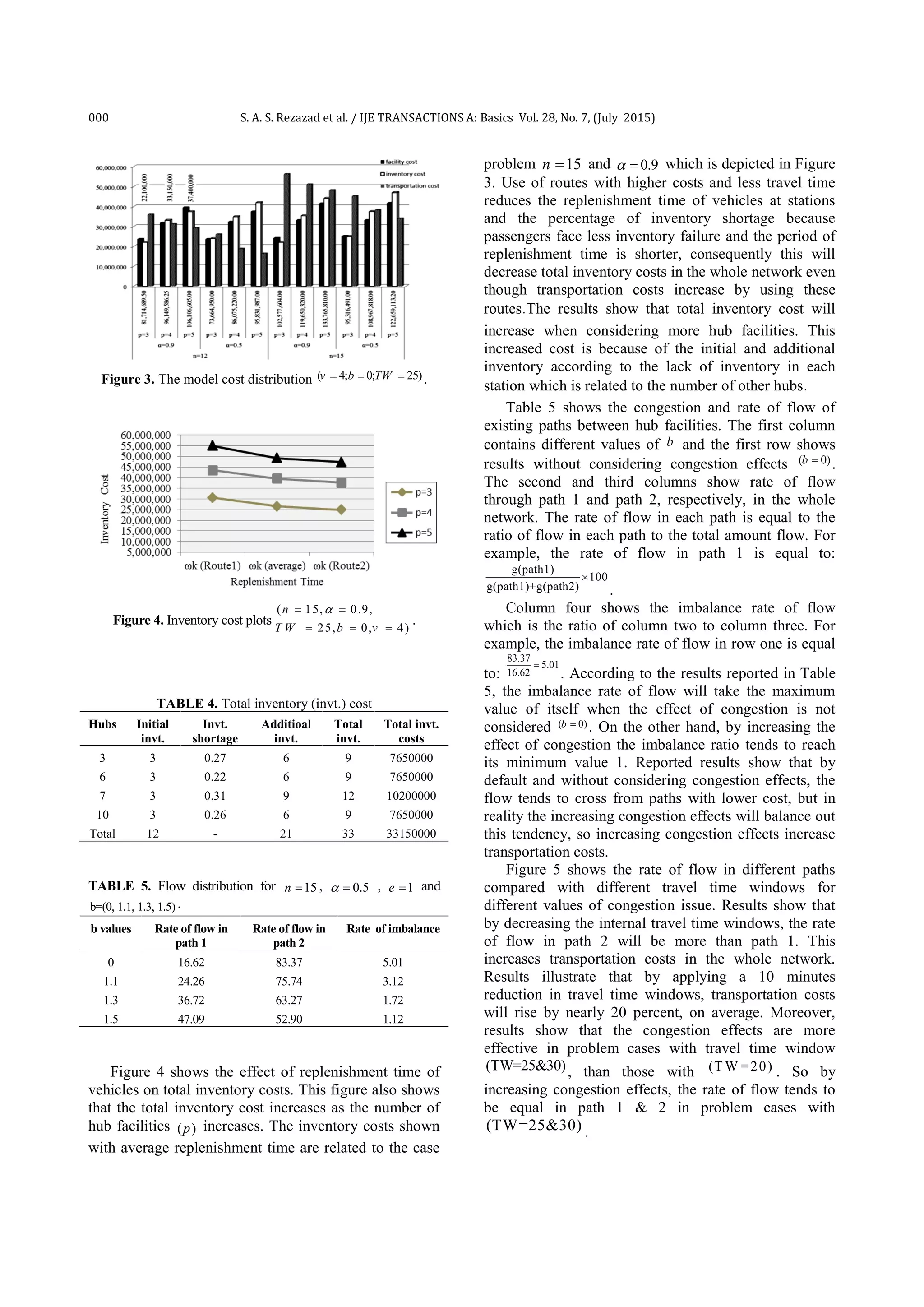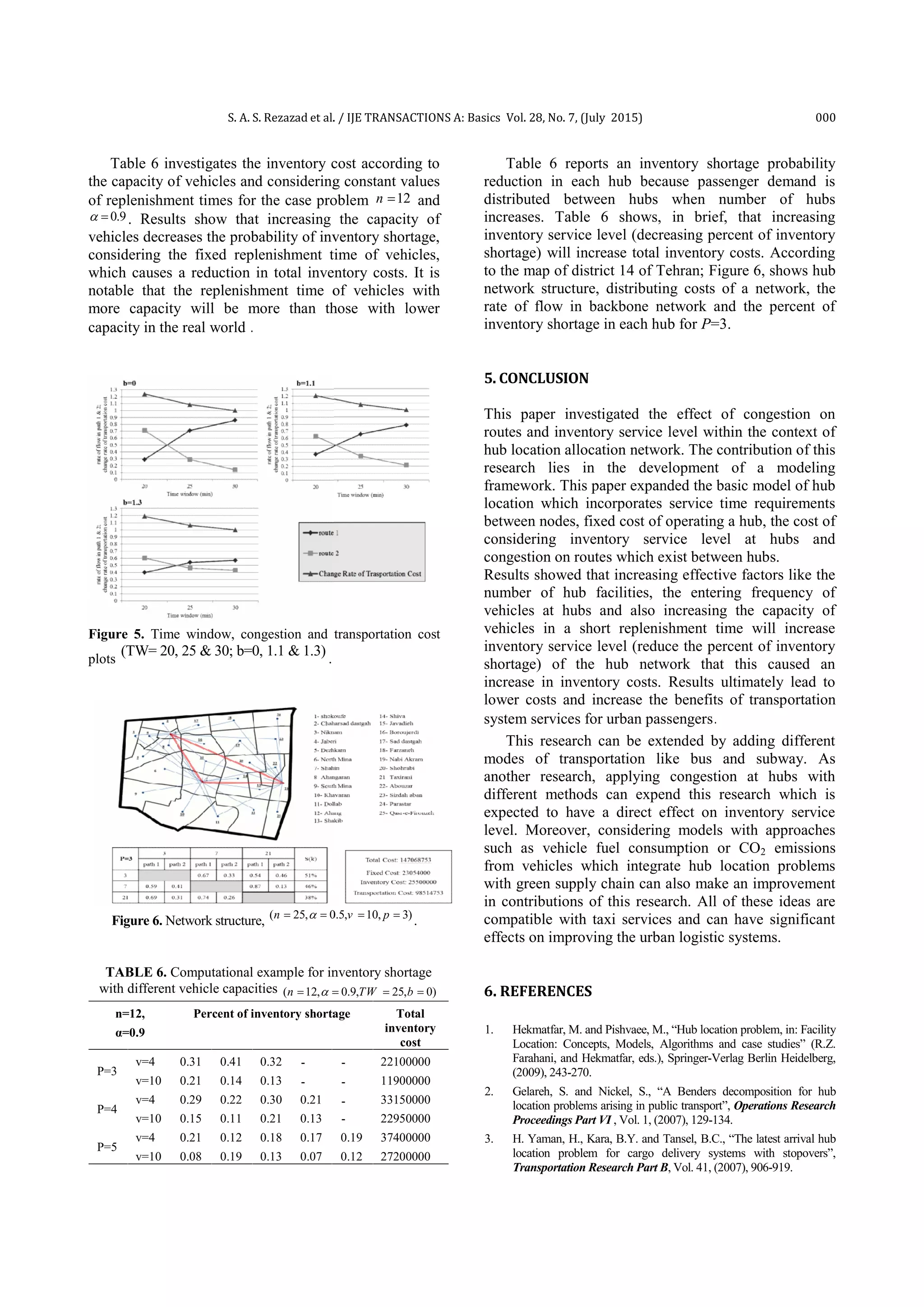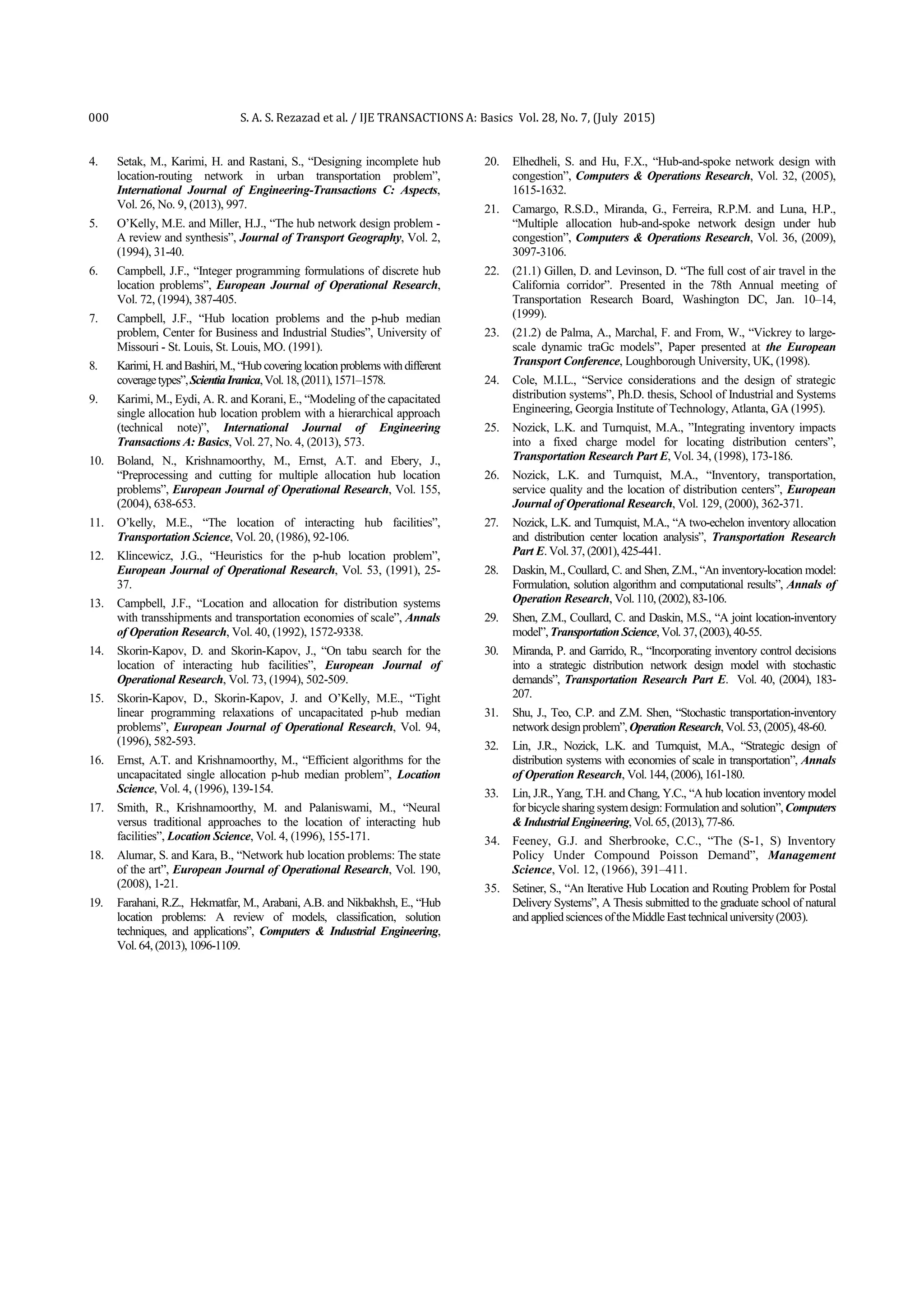This document summarizes a research paper that proposes a mathematical model for a hub location-allocation problem that considers inventory service levels at hubs and congestion on routes between hubs. The model aims to minimize transportation costs based on the probability of inventory shortage at hubs using double path routes between hubs that differ in travel time and cost. The model is evaluated using real taxi demand data from a municipality in Tehran. Prior research on hub location problems, congestion modeling, and inventory costs are also reviewed.
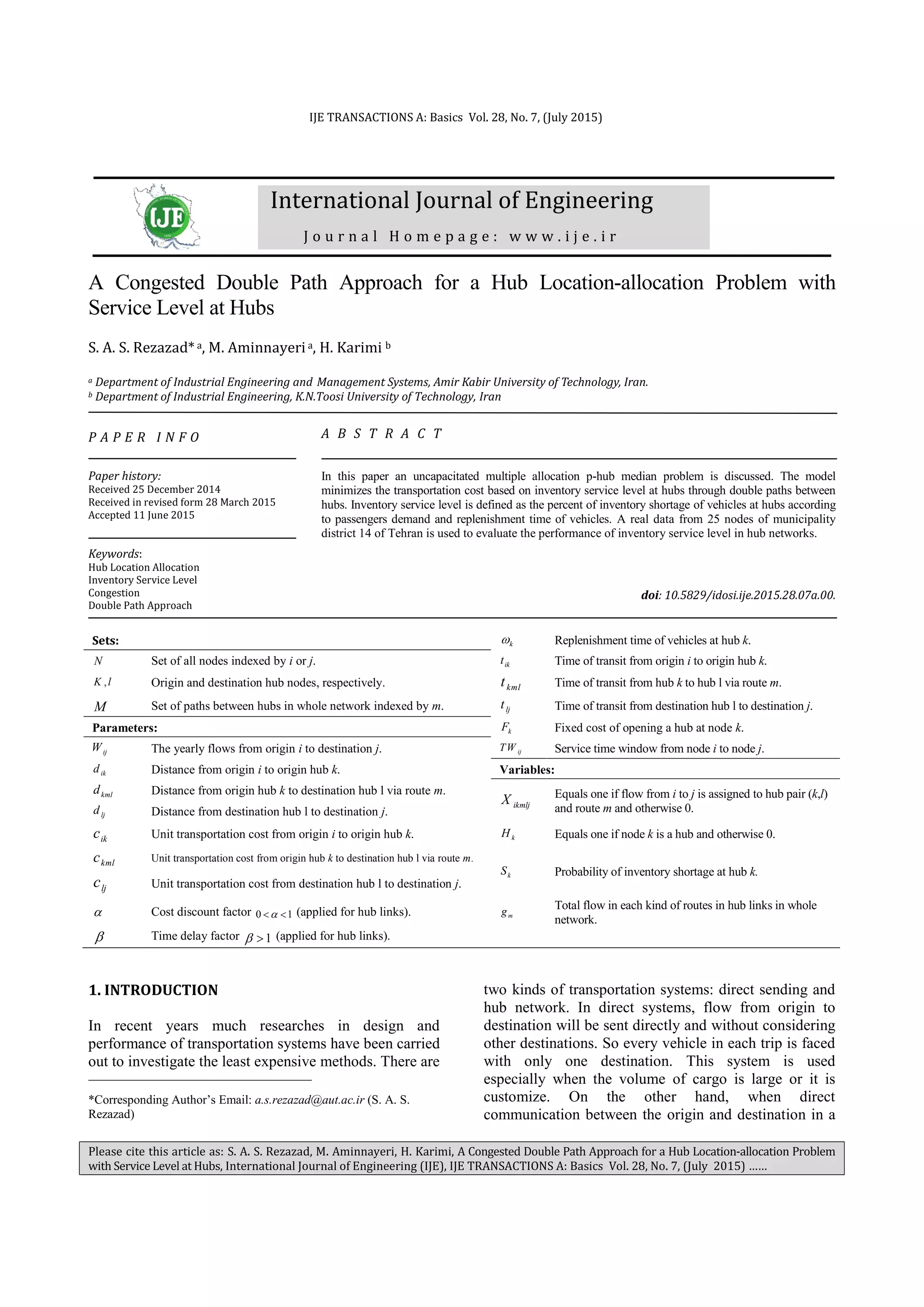
![S. A. S. Rezazad et al. / IJE TRANSACTIONS A: Basics Vol. 28, No. 7, (July 2015) 000
network is impossible or too costly, the second type of
system, the hub network is used. In this system the
flows are collected in a point which is called hub, and
then distributed between destinations. So in designing of
hub networks, strategic decision making like locating
hubs and assigning points of origins and destinations
should be adopted. Hub networks have the advantage
that the size of the vehicles will be determined by
economy, thus the economic benefits from the use of
vehicles and service level will be improved in this
system [1].
Taxi service is one of the applications of hub
location allocation problems. There are a lot of
terminals within the urban logistic network and paths
between each pair of origins and destinations should be
determined in such way that passengers reach their final
destination with the lowest cost and within a certain
time period. Public transportation were investigated in
hub location problems by Gelare and Nickel [2] and
Yaman et al. [3]. Moreover, an integrated incomplete
hub location-routing network is recently investigated by
Karimi and Setak [4], in a similar research. One of the
main applications of their model is the transportation
system, specially public and urban transportation.
Increased traffic and congestion in some routes
(especially connections between hub facilities), are
factors which may cause pauses and a lot of problems in
urban logistic systems. Because the volumes of daily
travel between hub facilities are greater than those
between other points in the network, this may cause
some disorders in urban transportation systems. In such
circumstances, using alternative paths to send flows
between hubs will improve the performance of the
network [5]. In this paper, a hub location allocation
problem for an urban logistic system is investigated
which contains two kinds of paths between hubs that
differ in terms of travel time and expense, such that
routes with a lower cost yield more travel time and vice
versa. Additionally, this paper also considers the
inventory service level at hubs and congestion on routes
between hub facilities in the whole network. The
contributions will be helpful in designating hub
networks with minimum vehicles at hubs to give good
services. According to congestion, this part of
contribution can be helpful to balance and manage
existing alternative paths between hub nodes and this is
helpfully applicable for limited zone by using traffic
cameras or some other related tools to control traffic in
real world. All of these applications are considered in
this work.
The rest of this paper is organized as follows:
section 2 presents and identifies the contribution of
relevant prior researches. The third section describes a
mixed integer nonlinear mathematical model.
Computational results and sensitivity analysis are
presented in section 4 and lastly, conclusions and
further research directions are discussed in section 5.
2. LITERATURE REVIEW
The literature related to this research can be found in
these main areas: p-hub median problems, hub problems
under congestion at hubs and location problems
considering inventory cost using the (S, S-1). The
mentioned areas are discussed below:
2. 1. pHMP Literature Although a variety of
models have been developed and investigated in the
context of hub related problems, they can be assigned to
the following main classes: the hub covering location
problem (HCLP) [6], the p-hub center problem (pHCP)
[6] and the p-hub median problem (pHMP) which is
related to this research. In a pHMP, the objective is to
locate “p” hubs in the network so that the total costs of
transporting flows through the network are minimized
[7]. Campbell [6] proposed pHCP based on the Mini-
Max criterion by which the maximum transportation
cost between all origin and destination pairs is
minimized. This type of problem is useful for
emergency facility locations. He also defined HCLP to
locate hubs in a way that each none-hub node is covered
by a pair of hub nodes. Karimi and Bashiri [8] presented
an adequate literature review of this problem and
developed a model with different coverage types.
There are two kinds of allocations: single and
multiple. In single allocation hub location problems,
each none-hub node is allocated to exactly one hub [9]
and in multiple allocations a none-hub node can be
allocated to more than one hub [10]. In this paper the
multiple allocation version of the p-hub median problem
is considered. The hub location problem was first
presented with a quadratic integer formulation by
O’Kelly [11]. He also proved that this is a NP-hard
problem. Klincewicz [12] presented two heuristics, one
based on exchanges of spoke assignments and the other
one based on clustering nodes. He also proposed the
tabu search and greedy randomized heuristic search.
Campbell [7] for the first time formulated pHMP with
multiple allocations as an integer programming model.
He also formulated an integer programming model
considering the threshold flow [13]. Skorin Kapov and
Skorin Kapov [14] presented a tabu search heuristic to
solve pHMP. Skorin Kapov et al. [15] formulated a
mixed integer pHMP and used an exact solution to solve
presented model. Ernest and Krishnamoorty [16]
proposed a linear programming formulation to solve the
pHMP and used simulated annealing to reach the upper
bound for the LP based branch and bound. Smith et al.
[17] solved the quadratic integer formulation using
neural networks. For more detailed information of hub](https://image.slidesharecdn.com/d954d0f1-7a9e-4dd6-8072-05bfb8058b1f-151108121220-lva1-app6892/75/my-final-paper-2-2048.jpg)
![000 S. A. S. Rezazad et al. / IJE TRANSACTIONS A: Basics Vol. 28, No. 7, (July 2015)
location problems the reader is referred to other works
[18, 19].
2. 2. Congestion Literature Elhedheli and Hu
[20] were the first who considered congestion issues in
the context of hub location problems. They considered
the congestion in an objective function using a convex
nonlinear cost function to balance congestion at hubs of
the network. Camargo et al. [21] also used the same
congestion function to establish a compromise between
the transportation cost savings induced by the
economies of scale exploitation and the costs associated
with the congestion effects. This paper also uses the
same function as a leverage tool to balance and
calculate congestion in any kind of path existing
between hubs in the whole network. The justification to
use such a function is discussed elsewhere [22] to
estimate delay cost and for airport management. In
particular, in the work of Palma and Marchal [23] it is
stated for traffic models which assume that congestion
cost is a power-law function. The same such function is
used in this paper. The congestion cost function is
aimed at balancing flow between existing paths in hub
to hub links, avoiding the case where one path is over-
utilized compared to other one. Over-utilized paths with
lower cost or paths with lower travel time will never
happen using the power-law congestion function.
Nowadays, congestion costs in real world is used a lot,
for example you can see in some crowded cities like
Tehran, to control traffic in specific routes, limited zone
policy is used. This policy by installing related tools like
traffic cameras is used to control the flows. All these
cases are considered as applications of congestion
function.
2. 3. Inventory Literature There is a lot of
research in the literature about the scope of location
problems considering inventory approaches that use
performance constraints to increase the efficiency of
networks, some are mentioned below: Cole [24]; Nozick
and Turnquist [25-27]; Daskin et al. [28]; Shen et al.
[29]; Miranda and Garrido [30]; Shu et al. [31]; Lin et
al. [32]. Although there is extensive literature about
jointed inventory and location, there are few studies that
have focused on the combined approaches of inventory
cost and the case of hub location problems. A
modulated hub inventory model applied in a bicycle
sharing system is included in the work by Lin et al. [33]
which considers a single hub covering problem for
bicycle sharing system where the bike stations play the
role of hubs in the network, and the origins, destinations
and hubs are considered in separated sets of nodes. They
use performance constraints to calculate the safety stock
of every hub. In this paper, due to the random nature of
demand, the Poisson distribution is utilized as a
performance constraint, and the service level inventory
shortage probability is evaluated at each hub. It’s
notable that origins, hubs and destinations are in the
same set of nodes.
3. MODEL FORMULATION
This problem is designated as a set of nodes with a
given travel time and demand of flow between nodes.
This model assumes that the network connections are in
place, so fixed costs for establishing network
connections are not considered. The objective is to
determine p hub nodes among all existing nodes in the
network such that the total costs are minimized and the
inventory service level according to passenger demand
and the replenishment time of vehicles is calculated at
each hub. In this paper, also congestion on existing
paths among backbone network (i.e., backbone network
included hubs and their links) is investigated.
The novelties of the model are highlighted as blow:
Considering a double path approach between hubs
Considering inventory service level at hubs
Considering congestion in existing paths
3. 1. Inventory Service Level Constraint To
ensure that the designed hub network is efficient enough
to hold passenger traffic at all hubs, many performance
constraints can be used in the hub location problems. In
the design of hub networks with taxi services, each hub
should have enough vehicles to give suitable services.
In hub network discussions, inventory level can be
defined as the existing inventory service level for users
of hub at each hub. So in order to investigate the ability
of inventory service level we calculate the lack
probability of the inventory service level at hubs
according to passenger demands and replenishment time
of vehicles. It’s notable that the inventory service level
includes the flows that use hub links to reach their
destinations. For example in Figure 1, the inventory
service level is calculated at hub k in scenarios “a”,
“d”, “f” and “g”. It is not investigated for the flows with
a single hub from an origin to a destination like
scenarios “b”, “c” and “e”. Assume that p hubs are
located and assigned to none-hub nodes in the whole
network. So each hub will face travel demands that
follows the Poisson distribution. In this case the demand
rate at hub k ( kA ) according to travel demand from
origin i to destination j via hubs k and l will be
calculated as below, where ikmljX as a decision variable
takes value 1 if the flows from i to j are assigned to
hub k and l through pathm . We have ijW , the flow
from origin i to destination j , where usually Wij Wji .
T number of days per month, B number of hours per
day and v capacity of vehicles are used to convert](https://image.slidesharecdn.com/d954d0f1-7a9e-4dd6-8072-05bfb8058b1f-151108121220-lva1-app6892/75/my-final-paper-3-2048.jpg)
![S. A. S. Rezazad et al. / IJE TRANSACTIONS A: Basics Vol. 28, No. 7, (July 2015) 000
hourly demand to become proportional with
replenishment time of vehicles.
1
k ik m lj ij
i m l k j i
A X W
T N v
k N (1)
Assume that hub k has 1p vehicles (number of other
hubs). If the demand rate at each hub kA and the
replenishment time of vehicles at each hub is considered
as k , then D the potential rate of demand that will face
the lack of vehicles at hub k has a Poisson distribution
with the mean rate of ( )k kA . In this case the
probability of inventory shortage at hub k ( )kS
will be
calculated as below based on Palm’s theorem. Palm’s
theorem states that number of demands in replenishment
time (re-supply) follows a Poisson distribution with
parameter ( )k kA [34].
1
0
( )
Pr ( 1)
!
( )
1
!
k k
k k
A q
k k
k
q p
A qp
k k
q
e A
obability D p s
q
e A
q
k N (2)
Here the inventory service level will be calculated as
follows: first, we consider 1p initial vehicles for each
hub, then according to passenger demands and the
replenishment time of vehicles, inventory shortage
probability will be calculated by Equations (1) and (2).
According to Table 1 and achieved inventory shortage
probability, an additional inventory will be assigned to
each hub.
And in the last step, by using h as the inventory
holding cost, the total inventory cost will be calculated
and applied in an objective function by inventory
function ( )k which is defined as below:
( ) ( 1)( 10* 1)k k ks p s h k N (3)
3. 2. Congestion Constraint Because of the
responsibility of distributing flows between existing
paths between hubs, and to reduce total congestion of
vehicles and balance the whole network, monetary
values must be expressed. In this case to calculate
congestion on routes, we use congestion function m and
define congestion decision variable mg , to apply its cost
in the objective function as Equation (4) where m M ,
and M is a set of routes and includes two kinds of
paths. One path, namely path 1, is based on less cost and
more travel time while, path 2 is based on less traveling
time and more cost.
m ik m lj ij
i k l k j i
g X W
m M (4)
The congestion cost function ( )m mg is assumed to be
given for each kind of paths existing between hubs in
the whole network. This function is considered
increasing on [0, )
, proper convex and smooth. The
used congestion cost function is a power law and is used
as a penalty cost in the objective function where
( ) ( )b
m m mg e g
,
e
and
b
take positive values, and
1b
to balance the flow rate in each path. This class of
function has been used by Elhedheli and Hu [20] and
Camargo et al. [21] for single and multiple allocations
to investigate hub congestion, respectively, while in this
study the function is used to investigate congestion on
paths between hubs in the whole multiple allocations
hub network. Figure 2 shows the congestion cost
function for different values of b
. It’s visible that by
increasing
b
, congestion function will have more power
to balance the flow between paths.
Figure 1. Different conditions of transporting flows
Figure 2. Congestion cost function for different values of b
TABLE 1. Inventory shortage scenarios
Probability of
inventory shortage
Initial
inventory
Additional
inventory
Total inventory
[0-0.1) p-1 0 p-1
[0.1-0.2) p-1 1*(p-1) 2*(p-1)
[0.2-0.3) p-1 2*(p-1) 3*(p-1)
[0.3-0.4) p-1 3*(p-1) 4*(p-1)
[0.4-0.5) p-1 4*(p-1) 5*(p-1)
[0.5-0.6) p-1 5*(p-1) 6*(p-1)
[0.6-0.7) p-1 6*(p-1) 7*(p-1)
[0.7-0.8) p-1 7*(p-1) 8*(p-1)
[0.8-0.9) p-1 8*(p-1) 9*(p-1)
[0.9-1) p-1 9*(p-1) 10*(p-1)
S. A. S. Rezazad et al. / IJE TRANSACTIONS A: Basics Vol. 28, No. 7, (July 2015) 000
hourly demand to become proportional with
replenishment time of vehicles.
1
k ik m lj ij
i m l k j i
A X W
T N v
k N (1)
Assume that hub k has 1p vehicles (number of other
hubs). If the demand rate at each hub kA and the
replenishment time of vehicles at each hub is considered
as k , then D the potential rate of demand that will face
the lack of vehicles at hub k has a Poisson distribution
with the mean rate of ( )k kA . In this case the
probability of inventory shortage at hub k ( )kS
will be
calculated as below based on Palm’s theorem. Palm’s
theorem states that number of demands in replenishment
time (re-supply) follows a Poisson distribution with
parameter ( )k kA [34].
1
0
( )
Pr ( 1)
!
( )
1
!
k k
k k
A q
k k
k
q p
A qp
k k
q
e A
obability D p s
q
e A
q
k N (2)
Here the inventory service level will be calculated as
follows: first, we consider 1p initial vehicles for each
hub, then according to passenger demands and the
replenishment time of vehicles, inventory shortage
probability will be calculated by Equations (1) and (2).
According to Table 1 and achieved inventory shortage
probability, an additional inventory will be assigned to
each hub.
And in the last step, by using h as the inventory
holding cost, the total inventory cost will be calculated
and applied in an objective function by inventory
function ( )k which is defined as below:
( ) ( 1)( 10* 1)k k ks p s h k N (3)
3. 2. Congestion Constraint Because of the
responsibility of distributing flows between existing
paths between hubs, and to reduce total congestion of
vehicles and balance the whole network, monetary
values must be expressed. In this case to calculate
congestion on routes, we use congestion function m and
define congestion decision variable mg , to apply its cost
in the objective function as Equation (4) where m M ,
and M is a set of routes and includes two kinds of
paths. One path, namely path 1, is based on less cost and
more travel time while, path 2 is based on less traveling
time and more cost.
m ik m lj ij
i k l k j i
g X W
m M (4)
The congestion cost function ( )m mg is assumed to be
given for each kind of paths existing between hubs in
the whole network. This function is considered
increasing on [0, )
, proper convex and smooth. The
used congestion cost function is a power law and is used
as a penalty cost in the objective function where
( ) ( )b
m m mg e g
,
e
and
b
take positive values, and
1b
to balance the flow rate in each path. This class of
function has been used by Elhedheli and Hu [20] and
Camargo et al. [21] for single and multiple allocations
to investigate hub congestion, respectively, while in this
study the function is used to investigate congestion on
paths between hubs in the whole multiple allocations
hub network. Figure 2 shows the congestion cost
function for different values of b
. It’s visible that by
increasing
b
, congestion function will have more power
to balance the flow between paths.
Figure 1. Different conditions of transporting flows
Figure 2. Congestion cost function for different values of b
TABLE 1. Inventory shortage scenarios
Probability of
inventory shortage
Initial
inventory
Additional
inventory
Total inventory
[0-0.1) p-1 0 p-1
[0.1-0.2) p-1 1*(p-1) 2*(p-1)
[0.2-0.3) p-1 2*(p-1) 3*(p-1)
[0.3-0.4) p-1 3*(p-1) 4*(p-1)
[0.4-0.5) p-1 4*(p-1) 5*(p-1)
[0.5-0.6) p-1 5*(p-1) 6*(p-1)
[0.6-0.7) p-1 6*(p-1) 7*(p-1)
[0.7-0.8) p-1 7*(p-1) 8*(p-1)
[0.8-0.9) p-1 8*(p-1) 9*(p-1)
[0.9-1) p-1 9*(p-1) 10*(p-1)
S. A. S. Rezazad et al. / IJE TRANSACTIONS A: Basics Vol. 28, No. 7, (July 2015) 000
hourly demand to become proportional with
replenishment time of vehicles.
1
k ik m lj ij
i m l k j i
A X W
T N v
k N (1)
Assume that hub k has 1p vehicles (number of other
hubs). If the demand rate at each hub kA and the
replenishment time of vehicles at each hub is considered
as k , then D the potential rate of demand that will face
the lack of vehicles at hub k has a Poisson distribution
with the mean rate of ( )k kA . In this case the
probability of inventory shortage at hub k ( )kS
will be
calculated as below based on Palm’s theorem. Palm’s
theorem states that number of demands in replenishment
time (re-supply) follows a Poisson distribution with
parameter ( )k kA [34].
1
0
( )
Pr ( 1)
!
( )
1
!
k k
k k
A q
k k
k
q p
A qp
k k
q
e A
obability D p s
q
e A
q
k N (2)
Here the inventory service level will be calculated as
follows: first, we consider 1p initial vehicles for each
hub, then according to passenger demands and the
replenishment time of vehicles, inventory shortage
probability will be calculated by Equations (1) and (2).
According to Table 1 and achieved inventory shortage
probability, an additional inventory will be assigned to
each hub.
And in the last step, by using h as the inventory
holding cost, the total inventory cost will be calculated
and applied in an objective function by inventory
function ( )k which is defined as below:
( ) ( 1)( 10* 1)k k ks p s h k N (3)
3. 2. Congestion Constraint Because of the
responsibility of distributing flows between existing
paths between hubs, and to reduce total congestion of
vehicles and balance the whole network, monetary
values must be expressed. In this case to calculate
congestion on routes, we use congestion function m and
define congestion decision variable mg , to apply its cost
in the objective function as Equation (4) where m M ,
and M is a set of routes and includes two kinds of
paths. One path, namely path 1, is based on less cost and
more travel time while, path 2 is based on less traveling
time and more cost.
m ik m lj ij
i k l k j i
g X W
m M (4)
The congestion cost function ( )m mg is assumed to be
given for each kind of paths existing between hubs in
the whole network. This function is considered
increasing on [0, )
, proper convex and smooth. The
used congestion cost function is a power law and is used
as a penalty cost in the objective function where
( ) ( )b
m m mg e g
,
e
and
b
take positive values, and
1b
to balance the flow rate in each path. This class of
function has been used by Elhedheli and Hu [20] and
Camargo et al. [21] for single and multiple allocations
to investigate hub congestion, respectively, while in this
study the function is used to investigate congestion on
paths between hubs in the whole multiple allocations
hub network. Figure 2 shows the congestion cost
function for different values of b
. It’s visible that by
increasing
b
, congestion function will have more power
to balance the flow between paths.
Figure 1. Different conditions of transporting flows
Figure 2. Congestion cost function for different values of b
TABLE 1. Inventory shortage scenarios
Probability of
inventory shortage
Initial
inventory
Additional
inventory
Total inventory
[0-0.1) p-1 0 p-1
[0.1-0.2) p-1 1*(p-1) 2*(p-1)
[0.2-0.3) p-1 2*(p-1) 3*(p-1)
[0.3-0.4) p-1 3*(p-1) 4*(p-1)
[0.4-0.5) p-1 4*(p-1) 5*(p-1)
[0.5-0.6) p-1 5*(p-1) 6*(p-1)
[0.6-0.7) p-1 6*(p-1) 7*(p-1)
[0.7-0.8) p-1 7*(p-1) 8*(p-1)
[0.8-0.9) p-1 8*(p-1) 9*(p-1)
[0.9-1) p-1 9*(p-1) 10*(p-1)](https://image.slidesharecdn.com/d954d0f1-7a9e-4dd6-8072-05bfb8058b1f-151108121220-lva1-app6892/75/my-final-paper-4-2048.jpg)
![000 S. A. S. Rezazad et al. / IJE TRANSACTIONS A: Basics Vol. 28, No. 7, (July 2015)
3. 3. Mathematical Model To present the model
formulation the following symbols, variables and
parameters are introduced. The congested multiple
allocations p-hub median problem considering
inventory service level at hubs now can be stated as
follows:
( )
( ) ( )
ij ikmlj ik ik kml kml lj lj
i k m l j
k k k k m m
k k m
Minimum W X d c d c d c
F H s g
(5)
Subject to:
k
k
H p (6)
1ikmlj
k m l
X ,i j N (7)
ikmlj l
k
X H , ,i j l N m M (8)
ikmlj k
l
X H , ,i j k N m M (9)
1
k ikmlj ij
i m l k j i
A X W
TNv
k N (10)
( )1
0
( )
1
!
k kA qp
k k
k
q
e A
S
q
k N (11)
m ikmlj ij
i k l k j i
g X W
m M (12)
( * )ikmlj ik kml lj ij
k m l
X t t t TW ,i j N (13)
{0,1}ikmljX , , ,i k l j N m M (14)
0ikmljX ( ), , ,i j kl j N m M (15)
, 0k mA g k N m M (16)
0 1kS k N (17)
{0,1}kH k N (18)
In the above mathematical model the objective function
(5) minimizes the sum of total transportation costs for
all origins to destination flows, sum of installation costs
of hub facilities, congestion costs on routes in the whole
network and inventory costs at hubs. The exact number
of hubs is p due to Constraint (6). Constraint (7)
ensures that every origin-destination node pair is
assigned to a hub pair and at least one kind of route
exists between hubs. It is notable that the choice of hub
assignments and route is based on the best economic
option. An origin-destination flow ijW
can be assigned to
node pair ( , )k l only if k and l are hubs. Constraints (8)
and (9) express these requirements. Constraints (10) and
(11) define the calculation of the probability of
inventory shortage at node k . Constraint (12)
determines the total amount of flow on existing routes
between hubs in the whole network. Constraint (13)
guarantees that all inter-urban travel time from origin i
to destination j should be done within the service time
window. Constraints (14) to (18) express the type and
the range of decision variables of the model.
4. COMPUTIONAL RESULTS
4. 1. Input Data and Parameters Datasets of
district 14 in Tehran are used in order to evaluate the
proposed model. In this dataset, 25 parishes of district
14 have been considered as the set of nodes. The
distance matrix of these nodes and time dataset are
gathered from Google maps. In order to generate the
demand matrix, first the population of each node was
considered and according to phrase (19) and (20), the
demand matrix between nodes was provided [35].
25
1
j
ij i
k i
k
p
W Q p
p p
; , 1,..., 25i j i j (19)
0i jW ; , 1,...,25i j i j (20)
in which Pi is considered as the population of node i,
and Wij is the demand flow from node i to node j.
According to this, it is obvious that the demand matrix
is an asymmetric matrix in which Wij Wji. Q is used as
a normalization factor. The replenishment time for node
k was calculated by adding the maximum existing time
from node k to other nodes and the maximum existing
time from other nodes to node k was calculated and then
the calculated phrase in each node was multiplied with
factor ( 1) to account for delay time. This
procedure will be carried out for each one of the routes,
(Replenishment time for node k based on route 1 and
route 2) and the average will be considered as the
replenishment time of each node. Phrase (21) to (23)
show the procedure used to calculate the replenishment
time for node k.
( 1)
(max{ } max{ })
k
kl lk
Route
t l N t l N
k N (21)
( 2)
(max{ } max{ })
k
kl lk
R oute
t l N t l N
k N (22)](https://image.slidesharecdn.com/d954d0f1-7a9e-4dd6-8072-05bfb8058b1f-151108121220-lva1-app6892/75/my-final-paper-5-2048.jpg)
